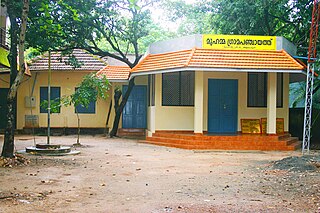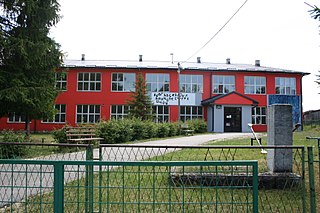
A village is a clustered human settlement or community, larger than a hamlet but smaller than a town, with a population typically ranging from a few hundred to a few thousand. Although villages are often located in rural areas, the term urban village is also applied to certain urban neighborhoods. Villages are normally permanent, with fixed dwellings; however, transient villages can occur. Further, the dwellings of a village are fairly close to one another, not scattered broadly over the landscape, as a dispersed settlement.

Lagaan: Once Upon a Time in India is a 2001 Indian Hindi-language epic musical sports drama film written and directed by Ashutosh Gowariker. The film was produced by Aamir Khan, who stars alongside debutant Gracy Singh and British actors Rachel Shelley and Paul Blackthorne. Set in 1893, during the late Victorian period of India's colonial British Raj, the film follows the inhabitants of a village in Central India, who, burdened by high taxes and several years of drought, are challenged by an arrogant British Indian Army officer to a game of cricket as a wager to avoid paying the taxes they owe. The villagers face the arduous task of learning a game that is alien to them and play for a victory.

Vijayadashami, also known as Dussehra, Dasara or Dashain, is a major Hindu festival celebrated every year at the end of Navaratri. It is observed on the tenth day of the month of Ashvin, the seventh in the Hindu Luni-Solar Calendar. The festival which typically falls in the Gregorian calendar months of September and October.

Robert Thomas Christgau is an American music journalist and essayist. Among the most well-known and influential music critics, he began his career in the late 1960s as one of the earliest professional rock critics and later became an early proponent of musical movements such as hip hop, riot grrrl, and the import of African popular music in the West. Christgau spent 37 years as the chief music critic and senior editor for The Village Voice, during which time he created and oversaw the annual Pazz & Jop critics poll. He has also covered popular music for Esquire, Creem, Newsday, Playboy, Rolling Stone, Billboard, NPR, Blender, and MSN Music, and was a visiting arts teacher at New York University. CNN senior writer Jamie Allen has called Christgau "the E. F. Hutton of the music world – when he talks, people listen."

A model village is a type of mostly self-contained community, built from the late 18th century onwards by landowners and business magnates to house their workers. Although the villages are located close to the workplace, they are generally physically separated from them and often consist of relatively high-quality housing, with integrated community amenities and attractive physical environments. "Model" is used in the sense of an ideal to which other developments could aspire.
Gram panchayat is a basic governing institution in Indian villages. It is a political institution, acting as cabinet of the village. The Gram sabha work as the general body of the Gram panchayat. The members of the Gram panchayat are elected directly by the people. The President of Gram Panchayat is called Pradhan or Sarpanch
The Kuot language, or Panaras, is a language isolate, the only non-Austronesian language spoken on the island of New Ireland, Papua New Guinea. Lindström estimates that there are 1,500 fluent speakers of Kuot. Perhaps due to the small speaker base, there are no significant dialects present within Kuot. It is spoken in 10 villages, including Panaras village of Sentral Niu Ailan Rural LLG in New Ireland Province.

Panchayati raj is the system of local self-government of villages in rural India as opposed to urban and suburban municipalities.

Stapari is a village located in the Užice municipality of Serbia. In the 2002 census, the village had a population of 974.
Banjevac is a village in Serbia. It is situated in the Krupanj municipality, in the Mačva District of Central Serbia.
Tuzinje is a village in the municipality of Sjenica, Serbia. According to the 2002 census, the village has a population of 204 people.
Dubovo is a village in the municipality of Tutin, Serbia. According to the 2002 census, the village has a population of 916 people.
Gornji Crniš is a village in the municipality of Tutin, Serbia. According to the 2002 census, the village has a population of 36 people.
Paljevo is a village in the municipality of Tutin, Serbia. According to the 2002 census, the village has a population of 369 people.
Potkrš is a village in the municipality of Prijepolje, Serbia. According to the 2002 census, the village has a population of 124 people.
Dolgovo is a rural locality in Kubenskoye Rural Settlement, Vologodsky District, Vologda Oblast, Russia. The population was 9 as of 2002. The village was originally named Bogoyavlensky after a Russian Orthodox bishop, but was later renamed in honor of Pyotr Dolgov, a Soviet colonel in the Airborne forces, who perished after a fatal accident during a high-altitude parachute jump in 1962. He was born into a family of farmers in this village.
Sarayevo is a rural locality in Mayskoye Rural Settlement, Vologodsky District, Vologda Oblast, Russia. The population was 2 as of 2002.
Semenkovo is a rural locality in Mayskoye Rural Settlement, Vologodsky District, Vologda Oblast, Russia. The population was 1 as of 2002.
Pandav Lila or Pandav Nritya is a ritual re-enactment of stories from the Hindu epic Mahabharata, through singing, dancing and recitation, that is practised in the Garhwal region of Uttarakhand, India. Pandavas are the five protagonists in the epic and the village amateurs take on their roles and perform the lila outdoors, accompanied by the folk instruments dhol, damau and two long trumpets called bhankore. The performances, which can last anywhere from three days to a month in different villages, draw large crowds and are an important cultural highlight of the year. The ritualistic drama features actors who often spontaneously become "possessed" by the spirits of their characters and begin to dance.







